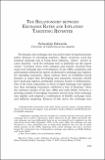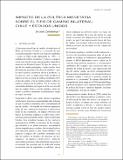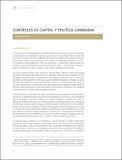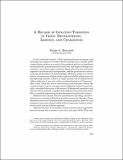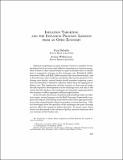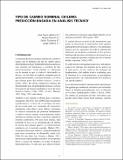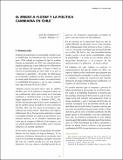Search
Now showing items 1-10 of 51
The relationship between exchange rates and inflation targeting revisited
For decades, the exchange rate was at the center of macroeconomic policy debates in emerging markets. Many countries used the nominal exchange rate to bring down inflation, –others—mostly in Latin America—used the exchange rate to implicitly tax the export sector. Currency crises were common and usually ...
Impacto de la política monetaria sobre el tipo de cambio bilateral: Chile y Estados Unidos
Este artículo analiza la reacción del tipo de cambio entre pesos Chilenos y dólares estadounidenses a las medidas de política monetaria que se adoptan en Chile y Estados Unidos. Se corre una regresión a la variación del tipo de cambio frente a un anuncio de política, sobre la variación de la tasa de ...
Controles de capital y política cambiaria
El análisis empírico de este estudio sugiere que un objetivo de política cambiaria y el temor de un sobrecalentamiento de la economía nacional han sido los dos motivos más importantes para la (re) introducción y persistencia de los controles de capital de la última década. Los controles de capital se ...
Inflation targeting in Brazil: shocks, backward-looking prices, and IMF conditionality
In mid-January 1990, Brazil abandoned its crawling exchange rate band. Surprisingly enough, the country's economic performance in the aftermath of this episode was much better than expected, given the performance of other emerging market economies after a move toward floating. Despite the large ...
A decadeof inflation targeting in Chile: developments, lessons, and challenges
In the twentieth century, Chile experienced most monetary and exchange rate regimes. Periods of fixed exchange rates usually ended in speculative attacks as a result of inconsistent policies or significant external shocks, generating serious real costs and larger exchange rate volatility.
Inflation targeting and the inflation process: lessons from an open economy
Inflation targeting in an open economy insolves a number of complexities that do not arise with inflation targeting in a clises economy. One of these is that central banks in open economies have to decide how to repond to changes in the exchange rate.
Tipo de cambio nominal Chileno: predicción basada en análisis técnico
Este trabajo presenta un resumen de las principales medidas utilizadas en el análisis técnico de la paridad peso-dólar. Se explica la interpretación y el uso que los analistas técnicos dan a estas medidas. Asimismo, se realizan ejercicios que evalúan la capacidad del Índice de Fuerza Relativa (RSI) ...
Fiscal inflation and cosmetic defaults in a small open economy
For a small open economy, maintaining a stable exchange rate and moderate levels of inflation is often a goal of primary importance. At the same time, the profession has recognized the tight link between fiscal and monetary policies in determining inflation dynamics. Thus, the goal of a stable exchange ...
The carry trade in industrialized and emerging markets
The profitability of currency carry trades in and of itself is 'economic' evidence against the uncovered interest parity (UIP) condition. There is a wide variety of 'statistical' evidence against UIP. Yet the relationship between these two types of evidence and their implications for time variation ...
El miedo a flotar y la política cambiaria en Chile
Este artículo revisa las políticas de manejo cambiario en Chile, poniendo particular énfasis en el régimen de tipo de cambio flotante implementado en 1999 y los dos episodios de intervención cambiaria posteriores a este. Se presenta evidencia de las favorables condiciones existentes en Chile para ...

